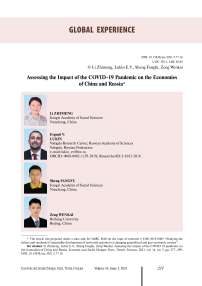Assessing the Impact of the COVID-19 Pandemic on the Economies of China and Russia
Автор: Li Zhimeng, Lukin E.V., Sheng Fangfu, Zeng Wenkai
Журнал: Economic and Social Changes: Facts, Trends, Forecast @volnc-esc-en
Рубрика: Global experience
Статья в выпуске: 5 т.14, 2021 года.
Бесплатный доступ
The COVID-19 pandemic has significantly affected economic development in countries around the world. It aggravated existing problems and increased the demand for economic transformation, modernization and qualitative development, triggered a new technological reform, which led to the emergence of new economic business forms and new consumption. The article assesses the impact of the COVID-19 pandemic on the economies of China and Russia. To achieve this goal, we review the state of business activity in the manufacturing and non-manufacturing sectors of the national economy, and summarize the main measures of the anti-pandemic policy implemented by the Chinese and Russian governments. We look into the dynamics of functioning of offline economic spheres that are aimed at personal communication (tourism, catering, retail, transport, culture, entertainment), as well as online spheres implying human-computer interaction (electronic retailing, express delivery, remote work, telemedicine) in the context of the COVID-19 pandemic. We make conclude that the extent of COVID-19 impact on the economy depends on the effectiveness of measures for its prevention and control. We are convinced that at the moment it is necessary to correlate these measures with economic and social development policies, and take into consideration increased consumption as an important aspect of mitigating the effects of COVID-19, accelerate the transformation and modernization of traditional industries, actively develop new economic business forms and build a more open monetary circulation both within the country and globally, thus enhancing the role of the state in global supply chains.
China, Russia, COVID-19 pandemic, economy, impact
Короткий адрес: https://sciup.org/147234820
IDR: 147234820 | УДК: 338.1 | DOI: 10.15838/esc.2021.5.77.16
Текст научной статьи Assessing the Impact of the COVID-19 Pandemic on the Economies of China and Russia
The COVID-19 pandemic and the resulting social distancing, isolation, and travel restrictions have changed people’s lifestyles and production modes and affected global economic and social development. According to the World Bank, the volume of world trade as of the end of 2020 decreased by 9.5% compared to the previous year1. The implications of the COVID-19 pandemic have affected almost all economic sectors in one way or another. Airlines and cruise companies, casinos and hotels faced a reduction in the number of tourists by almost 90% [1]. A sharp decline in demand for food products on the part of hotels and restaurants led to a 20% drop in prices for agricultural products [2]. Negative dynamics were observed in many industries, in retail trade, and in the world commodity markets ( Figures 1 and 2 ). Oil prices collapsed by 34%, investment activity slowed down by 5.5%2.
As a result, global GDP dropped in the first quarter of 2020 by 8.1% compared to the level of the fourth quarter of 2019; the decline accelerated to 13.7% in the second quarter of 20203. According to the results of 2020, GDP decline in the world is estimated at 4.3% compared to 2019 (Tab. 1) . The decline and slowdown in economic dynamics were observed in most countries. At the same time, among major economies, China and Russia demonstrated one of the highest levels of resistance to the crisis caused by the COVID-19 pandemic.
The aim of our study is to assess the impact of the COVID-19 pandemic on the economies of China and Russia.
Prevention and control of the spread of COVID-19 in China and Russia
Prevention and control policies have become the foundation of China’s pandemic response strategy. The emphasis was placed on strict discipline in terms of compliance with quarantine measures, mass testing, and preventive transition to working
Figure 1. Dynamics of global economic activity indicators in 2020, % to the level of December 2019
Figure 2. Dynamics of world prices for certain goods in 2020, % to the level of December 2019
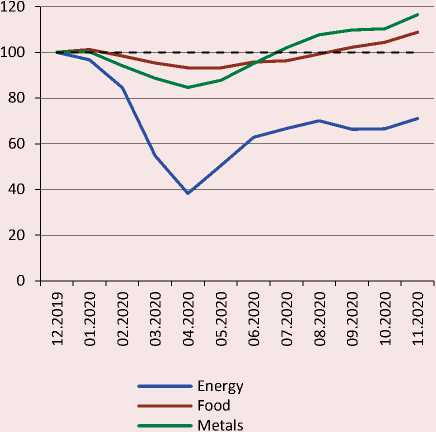
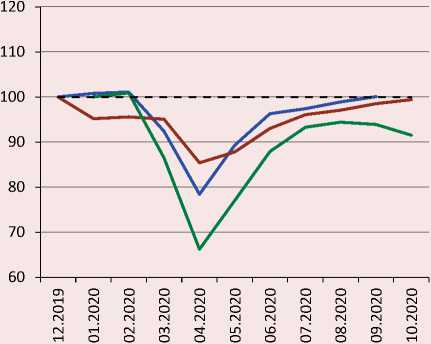
Retail trade
Industrial production
Population mobility
Table 1. GDP growth rate, in % relative to the previous year
|
Country |
2018 |
2019 |
2020 (estimate) |
2021 (forecast) |
2022 (forecast) |
|
World |
3.0 |
2.3 |
-4.3 |
4.0 |
3.8 |
|
Developed economies |
2.2 |
1.6 |
-5.4 |
3.3 |
3.5 |
|
United States |
3.0 |
2.2 |
-3.6 |
3.5 |
3.3 |
|
Euro area |
1.9 |
1.3 |
-7.4 |
3.6 |
4.0 |
|
Japan |
0.6 |
0.3 |
-5.3 |
2.5 |
2.3 |
|
Emerging markets and developing countries |
4.3 |
3.6 |
-2.6 |
5.0 |
4.2 |
|
East Asia and the Pacific Basin |
6.3 |
5.8 |
0.9 |
7.4 |
5.2 |
|
China |
6.6 |
6.1 |
2.0 |
7.9 |
5.2 |
|
Indonesia |
5.2 |
5.0 |
-2.2 |
4.4 |
4.8 |
|
Europe and Central Asia |
3.4 |
2.3 |
-2.9 |
3.3 |
3.9 |
|
Russia |
2.8 |
2.0 |
-3.0 |
2.6 |
3.0 |
|
Latin America and Caribbean countries |
1.9 |
1.0 |
-6.9 |
3.7 |
2.8 |
|
Brazil |
1.8 |
1.4 |
-4.5 |
3.0 |
2.5 |
|
Middle East and North Africa |
0.5 |
0.1 |
-5.0 |
2.1 |
3.1 |
|
Saudi Arabia |
2.4 |
0.3 |
-5.4 |
2.0 |
2.2 |
|
South Asia |
6.5 |
4.4 |
-6.7 |
3.3 |
3.8 |
|
India |
6.1 |
4.2 |
-9.6 |
5.4 |
5.2 |
|
Sub-Saharan Africa |
2.6 |
2.4 |
-3.7 |
2.7 |
3.3 |
|
Republic of South Africa |
0.8 |
0.2 |
-7.8 |
3.3 |
1.7 |
Rosstat.
Figure 3. Daily new confirmed cases of COVID-19 in China
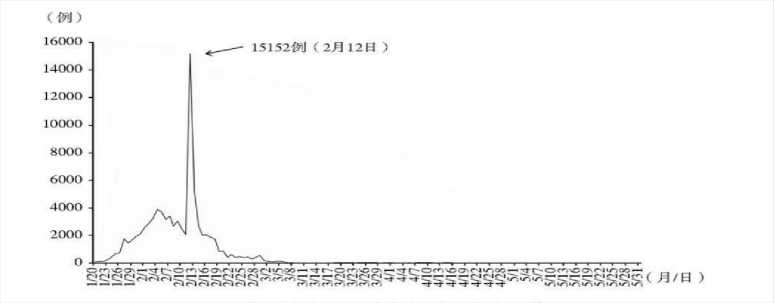
Note: 15,152 new confirmed cases of COVID-19 were reported on February 12 (13,332 clinically diagnosed cases in Hubei province were counted as the new confirmed cases on that day)
Source: Fighting COVID-19: China in Action.
Figure 4. Daily number of COVID-19 deaths in China
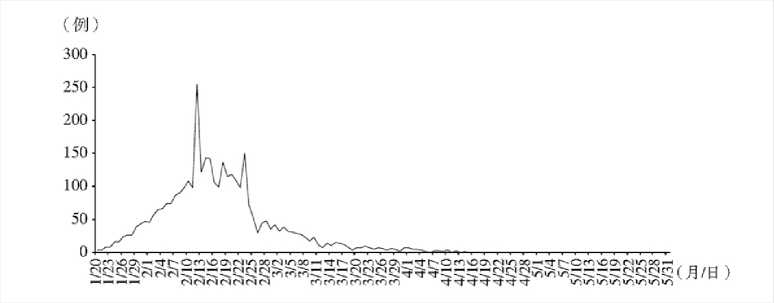
Source: Fighting COVID-19: China in Action.
from home. It took China just over a month to establish a preliminary control of the spread of COVID-19, about two months to reduce the number of daily new cases to less than ten, and about three months to achieve convincing results in the fight against COVID-19 in Wuhan and
Hubei, and also obtain significant strategic results in COVID-19 prevention and control (Fig. 3, 4) 4. Currently, the COVID-19 situation in China is under control, but due to imported cases, there are still periodic outbreaks of the virus in different regions of the country.
In the fight against coronavirus, Russia has chosen a strategy of extensive testing for and the earliest possible detection of COVID-195, compulsory monitoring of those who test positive, and a voluntary and advisable transition to remote work. The period of strict quarantine lasted six weeks, after which Russia started to relax the imposed restrictions for the population and business6 (Fig. 5) .
In general, we can note that the strategy China used to counter the spread of COVID-19 has proven highly effective. The Chinese authorities managed to suppress the pandemic very quickly and decisively and to prevent its second wave. The more lenient Russian strategy to combat the coronavirus looks less successful in comparison, but in many large countries the situation with the implementation of anti-pandemic policies was even more difficult. Thus, the death rate from COVID-19 in Russia (715 deaths per 1 million inhabitants) was significantly lower than in Italy (1,927), the UK (1,909), the United States (1,762), Brazil (1,675), Spain (1,645), France (1,514), Argentina (1,293) and Germany (960)7.
Figure 5. Daily number of COVID-19 cases and deaths in Russia
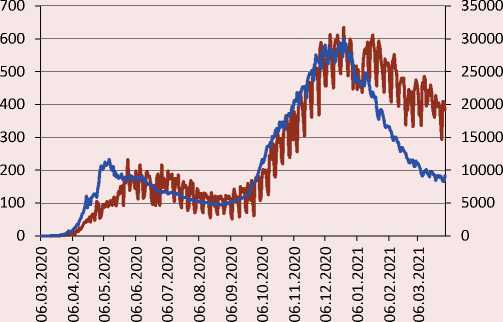
------Deaths ------Cases (right scale)
Список литературы Assessing the Impact of the COVID-19 Pandemic on the Economies of China and Russia
- Fernandes N. Economic effects of coronavirus outbreak on the world economy. IESE Business School Working Paper, 2020, no. WP-1240-E. DOI: 10.2139/ssrn.3557504.
- Nicola M., Alsafi Z., Sohrabi C., Kerwan A., Al-Jabir A., Iosifidis C., Agha M., Agha R. The socio-economic implications of the coronavirus and COVID-19 pandemic: A review. International Journal of Surgery, 2020, vol. 78, pp. 185–193. DOI: 10.1016/j.ijsu.2020.04.018.
- McKibbin W., Roshen F. The global macroeconomic impacts of COVID-19: Seven scenarios. CAMA Working Paper, 2020, vol. 19. DOI: 10.2139/ssrn.3547729.
- Goodell J.W. COVID-19 and finance: Agendas for future research. Finance Research Letters, 2020, vol. 35, 101512. DOI: 10.1016/j.frl.2020.101512.
- Zhang D., Hu M., Ji Q. Financial markets under the global pandemic of COVID-19. Finance Research Letters, 2020, vol. 36, 101528. DOI: 10.1016/j.frl.2020.101528.
- Ivanov D. Predicting the impacts of epidemic outbreaks on global supply chains: A simulation-based analysis on the coronavirus outbreak (COVID-19/SARS-CoV-2) case. Transportation Research. Part E: Logistics and Transportation Review, 2020, vol. 136, 101922. DOI: 10.1016/j.tre.2020.101922.
- Kvashnina I.A. The impact of the COVID–19 pandemic on the global economy and foreign direct investment flows. Vestnik Instituta ekonomiki Rossiiskoi akademii nauk=The Bulletin of the Institute of Economics of the Russian Academy of Sciences, 2020, no. 4, pp. 166–175 (In Russian).
- Carreno I., Dolle T., Medina L., Brandenburger M. The implications of the COVID-19 pandemic on trade. European Journal of Risk Regulation, 2020, vol. 11, no. 2, pp. 402–410. DOI: 10.1017/err.2020.48.
- Atkeson A. What will be the economic impact of COVID-19 in the US? Rough estimates of disease scenarios. NBER Working Paper, 2020, no. 26867. DOI: 10.3386/w26867.
- Nemova L.A. Canada’s economy and government policies in the times of the COVID-19 pandemic. Rossiya i Amerika v XXI veke=Russia and America in XXI Century, 2020, no. 2. DOI: 10.18254/S207054760010433-3 (In Russian).
- Dabrowski A. Japan and the COVID-19 Pandemic. PISM Bulletin, 2020, vol. 81 (1511), pp. 1–2.
- Codagnone C. et al. Assessing concerns for the economic consequence of the COVID-19 response and mental health problems associated with economic vulnerability and negative economic shock in Italy, Spain, and the United Kingdom. PLoS ONE, 2020. vol. 15 (10), 0240876. DOI: 10.1371/journal.pone.0240876.
- Bizyaev A.I., Mar’yasis D.A. On the issue of COVID-19 influence on the Israeli socio-economic development. Vestnik Instituta vostokovedeniya RAN=Journal of the Institute of Oriental Studies RAS, 2020, no. 3 (13), pp. 304– 316 (In Russian).
- Ataguba J.E. COVID-19 Pandemic, a war to be won: Understanding its economic implications for Africa. Applied Health Economics and Health Policy, 2020, vol. 18, pp. 325–328. DOI: 10.1007/s40258-020-00580-x.
- Kosevich E.Yu. Latin America: The coronavirus and the new political landscape. Latinskaya Amerika=Latin America, 2020, no. 10, pp. 39–53. DOI: 10.31857/S0044748X0011330-2 (In Russian).
- Muhammed A.K. COVID-19: Malaysia experience and key lessons. Asian Economic Papers, 2020, November, pp. 1–27. DOI: 10.1162/asep_a_00801.
- Ionova E.P. Central Asia under conditions of the pandemic. Rossiya i novye gosudarstva Evrazii=Russia and New States of Eurasia, 2020, no. 2 (47), pp. 81–93 (In Russian).
- Minakir P.A. Pandemic economy: The Russian way. Prostranstvennaya ekonomika=Spatial Economics, 2020, vol. 16, no. 2, pp. 7–18 (In Russian).
- Smotritskaya I.I. Russian economy on the background of global pandemics: The basic contours of “new reality”. Menedzhment i biznes-administrirovanie=Management and Business Administration, 2020, no. 2, pp. 4–15 (In Russian).
- Wang Min. Atypical impact of the epidemic on consumer behavior. Economic Forum, 2003, vol. 8.
- Li Zhimeng, Sheng Fangfu. Impacts of COVID-19 on China’s industry and consumption and relevant countermeasures. Jiangxi Social Sciences, 2020, vol. 3.
- Carter P., Anderson M., Mossialos E. Health system, public health, and economic implications of managing COVID-19 from a cardiovascular perspective. European Heart Journal, 2020, vol. 41, issue 27, pp. 2516–2518. DOI: 10.1093/eurheartj/ehaa342.
- Ulumbekova G.E., Ginoyan A.B., Petrachkov I.V. healthcare responses to COVID-19 in different countries. Demograficheskoe obozrenie=Demographic Review, 2020, vol. 7, no. 2, pp. 121–142 (In Russian).
- Laing T. The economic impact of the Coronavirus 2019 (Covid-2019): Implications for the mining industry. The Extractive Industries and Society, 2020, vol. 7, issue 2, pp. 580–582. DOI: 10.1016/j.exis.2020.04.003.
- Kondrat’ev V.B. Covid-19 and mining industry. Gornaya promyshlennost’=Russian Mining Industry Journal, 2020, no. 5, pp. 10–18 (In Russian).
- Korovkin V.V., Kuznetsova G.V. Prospects for digital transformation in Russian machine building industry. ArsAdministrandi. Iskusstvo upravleniya=ArsAdministrandi, 2020, vol. 12, no. 2, pp. 291–313 (In Russian).
- Kufelova I., Rakova M. Impact of the COVID-19 pandemic on the automotive industry in Slovakia and selected countries. SHS Web of Conferences, 2020, vol. 83, 01040. DOI: 10.1051/shsconf/20208301040.
- Zinov’eva N.G. Steel industry of the world and of Russia in pandemic environment. Chernaya metallurgiya. Byulleten’ nauchno-tekhnicheskoi i ekonomicheskoi informatsii=Ferrous Metallurgy. Bulletin of Scientific, Technical and Economical Information, 2020, vol. 76, no. 7, pp. 657–664 (In Russian).
- Siginevich D.A. The impact of the COVID-19 pandemic on the petrochemical industry. Innovatsii i investitsii=Innovation & Investment, 2020, no. 8, pp. 210–214 (In Russian).
- Zhong H., Tan Z., He Y., Xie L., Kang C. Implications of COVID-19 for the electricity industry: A comprehensive review. CSEE Journal of Power and Energy Systems, 2020, vol. 6, no. 3, pp. 489–495. DOI: 10.17775/CSEEJPES.2020.02500.
- Laborde D., Martin W., Swinnen J., Vos R. COVID-19 risks to global food security. Science, 2020, vol. 369, no. 6503, pp. 500–502. DOI: 10.1126/science.abc4765.
- Ceylan F., Özkan B. Assessing impacts of COVID-19 on agricultural production and food systems in the world and in Turkey. Gaziantep University Journal of Social Sciences, 2020, 19 (COVID-19 Special Issue), pp. 472–485. DOI: 10.21547/jss.784859.
- Gorbatov S., Gordeev D. Scientists analyzed the state of the Russian meat industry in the context of the coronavirus pandemic. Myasnye tekhnologii=Meat Technology, 2020, no. 7 (211), pp. 10–15 (In Russian).
- Weersink A., von Massow M., McDougall B. Economic thoughts on the potential implications of COVID-19 on the Canadian dairy and poultry sectors. Canadian Journal of Agricultural Economics, 2020. DOI: 10.1111/cjag.12240.
- Kemp P. S., Froese R., Pauly D. COVID-19 provides an opportunity to advance a sustainable UK fisheries policy in a post-Brexit brave new world. Marine Policy, 2020, 120, 104114. DOI: 10.1016/j.marpol.2020.104114.
- Klimova T.B. Dynamics of the aviation industry: Trends and pandemic challenges. Ekonomika. Informatika=Economics. Information Technologies, 2020, vol. 47, no. 3, pp. 512–521 (In Russian).
- Sobieralski J.B. COVID-19 and airline employment: Insights from historical uncertainty shocks to the industry. Transportation Research Interdisciplinary Perspectives, 2020, vol. 5, 100123. DOI: 10.1016/j.trip.2020.100123.
- Savushkina Yu.V. The railway industry under COVID-19. Innovatsii i investitsii=Innovation & Investment, 2020, no. 6, pp. 291–293 (In Russian).
- Hoque A., Shikha F.A., Hasanat M.W., Arif I., Hamid A.B.A. The effect of coronavirus (COVID-19) in the tourism industry in China. Asian Journal of Multidisciplinary Studies, 2020, vol. 3, no. 1, pp. 52–58.
- Gursoy D., Chi C.G. Effects of COVID-19 pandemic on hospitality industry: Review of the current situations and a research agenda. Journal of Hospitality Marketing & Management, 2020, 29:5, pp. 527–529. DOI: 10.1080/19368623.2020.1788231.
- Jones P., Comfort D. The COVID-19 crisis and sustainability in the hospitality industry. International Journal of Contemporary Hospitality Management, vol. 32, no. 10, pp. 3037–3050. DOI: https://doi.org/10.1108/IJCHM-04-2020-0357.
- Shahzad A., Hassan R., Abdullah I., Fareed M. COVID-19 impact on e-commerce usage: An empirical evidence from Malaysian healthcare industry. Humanities & Social Sciences Reviews, 2020, no. 8 (3), pp. 599–609. DOI: 10.18510/hssr.2020.8364.
- Poverinov A.I., Kunev S.V. Digital pharmaceutical promotion instruments in a pandemic condition. Fundamental’nye issledovaniya=Fundamental Research, 2020, no. 7, pp. 85–89 (In Russian).
- Nasonova I.A. Global advertising market: Impact of COVID-19. Ekonomika i biznes: teoriya i praktika=Economy and Business: Theory and Practice, 2020, no. 5-2 (63), pp. 105–108 (In Russian).
- Ibn-Mohammed T., Mustapha K.B., Godsell J., Adamu Z., Babatunde K.A., Akintade D.D., Acquaye A., Fujii H., Ndiaye M.M., Yamoah F.A., Koh S.C.L. A critical analysis of the impacts of COVID-19 on the global economy and ecosystems and opportunities for circular economy strategies. Resources, Conservation and Recycling, 2021, no. 164, 105169. DOI: 10.1016/j.resconrec.2020.105169.
- Chulanova O.L. Actualization of the free employment economy – gigonomics) – a trend in digital globalization in the context of the COVID-19 pandemic. Zhurnal issledovanii po upravleniyu=Journal of Management Studies, 2020, vol. 6, no. 3, pp. 3–22 (In Russian).

